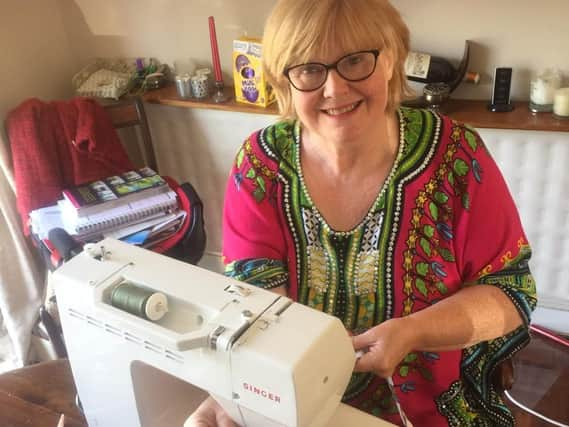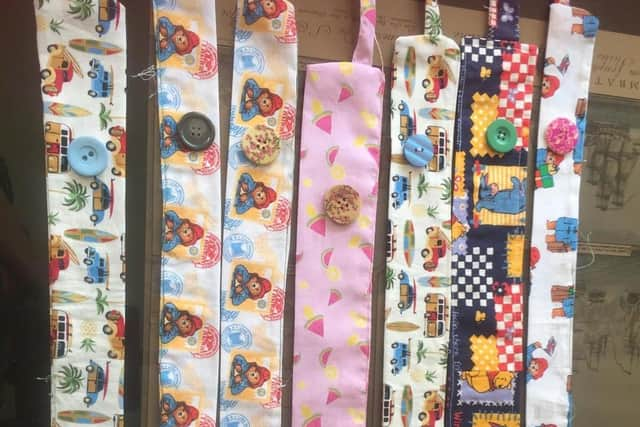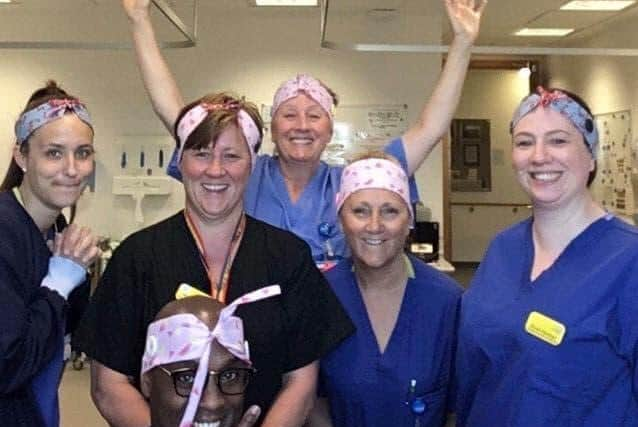Banbury teacher creates hundreds of reusable headbands to anchor face masks for NHS workers


The headbands, which can be washed and reused, help to reduce rubbing and stop the wearer getting uncomfortable when using face masks for long periods of time.
Catherine Daw, a business teacher at Banbury and Bicester College, started making the headbands at home after seeing an image on social media of nurses with sores on their faces after wearing PPE all day.
Advertisement
Hide AdAdvertisement
Hide AdCatherine said: “I’ve made headbands which have buttons on them, I asked if they would be helpful for nurses. The reason for this, is that when medical staff have to wear face masks all day, the elastic around their ears often rubs and causes them to have sore ears. So, I have been making headbands to prevent this.
“I put out an appeal on my village Facebook group and I very quickly got a response from a nurse who worked at the Horton Hospital in Banbury asking for some for her department.
“I couldn’t make them quickly enough as more and more people wanted them. Lots of ladies from my village helped with making and providing buttons and material and I wouldn’t have kept up with the supply without their help.”
The headbands are in high demand and have been used by NHS staff at the Horton Hospital in Banbury, North Bristol NHS Trust, The Nightingale Hospital London and Great Ormond Street Hospital, as well as in doctors' surgeries, wards and care homes nationwide.
Advertisement
Hide AdAdvertisement
Hide AdEsther Staples, records administrator at Cropedy Surgery in Banbury, said: “Cat donated to the surgery and had got some friends to help her. It’s just really nice that the community has come together and people like Cat and her friends have made these headbands for our surgery and for others.


“I think we’d be in a far worse situation if it wasn’t for people like Cat and all the other volunteers that are coming together to help the NHS.
“It gave the staff a little boost and that sense of not being alone because it’s very isolating. They’re seeing patients, but they haven’t got the same face-to-face contact and time to spend with people that they normally do.
“Things like the headbands are nice and cheerful and it just brightens up everyone's day, knowing that there are people out there thinking of them and appreciating them.
Advertisement
Hide AdAdvertisement
Hide Ad"It just gave staff morale a little boost and we’re really lucky.


“It’s all generations of people coming together to help one another out. It’s good that nice and positive things can come out of what really is a horrible situation.”
Julie Tinsley, orthopaedic practitioner at North Bristol NHS Trust, said: “I took 12 into my department and my colleagues were like locusts screaming ‘I want that one, I want that one’. We put them on and took a group photograph and they’ve continued to wear them each day.
“The headbands do two things; they keep your hair out of your eyes which is a big issue and obviously they anchor the face masks on.
Advertisement
Hide AdAdvertisement
Hide Ad“By the end of the day you’re a bit frazzled and so it does help. I’ve worn mine all day, and it’s stayed where it is, it’s brilliant and is definitely doing the job. Loads of people stop us on the ward and ask us where they’re from.”
Each headband takes around 10 minutes to make. The material used must be cotton or polyester and it is boil washed before being cut and pieced together on a sewing machine.
Afterwards, buttons are attached, which are the size of two-pound coins.
Catherine has since shared how to videos on local Facebook groups and more people have joined to support the effort to make headbands to protect the NHS.
Advertisement
Hide AdAdvertisement
Hide AdShe added: “This has taken on a life of its own! Some people have made headbands, some have provided fabric or buttons, everyone has been very helpful.
“The reason I did this is because I am very grateful to our fabulous NHS. I cannot imagine how they must feel going into work each day at the moment, and although the headbands are a very little thing, every little helps.
“We’ve helped so many people and I have made lots of new friends. We are all going to get together when this is all over.”
Anyone who would like to donate new fabric or buttons to support the making of more headbands, please contact [email protected].
*A message from the Banbury Guardian Editor:
Advertisement
Hide AdAdvertisement
Hide AdThank you for reading this story on our website. While I have your attention, I also have an important request to make of you.
In order for us to continue to provide high quality and trusted local news on this free-to-read site, I am asking you to also please purchase a copy of our newspaper when you do your weekly shop.
Our journalists are highly trained and our content is independently regulated by IPSO to some of the most rigorous standards in the world. But being your eyes and ears comes at a price. So we need your support more than ever to buy our newspapers during this crisis.
With the coronavirus lockdown having a major impact on many of our local valued advertisers - and consequently the advertising that we receive - we are more reliant than ever on you helping us to provide you with news and information by buying a copy of our newspaper.